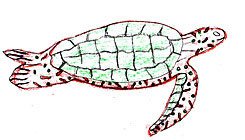How To: Teach the Sea from the Land
Lessons that mix science, writing, and art can bring the ocean to the classroom.
Your content has been saved!
Go to My Saved Content.This how-to article accompanies the feature "Imagining the Ocean: Art Mixes Well with Marine Science."

Don't live anywhere near an ocean? Don't fret. Integrating art, music, literature, and writing with a study of the sea doesn't require a physical body of water. Throughout the country, teachers use books, videos, poetry, and classroom aquariums to combine artsy lessons with the sea. Here are a few ideas to get you going:
Create a Nature Journal
Middle school science teacher Laurie Guest finds a way to make art a key part of nearly every science lesson. Her seventh graders at the Mare Island Technology Academy, in Vallejo, California, choose a seafaring species -- such as the harbor seal, black-footed albatross, or leatherback turtle -- and draw a picture of it, using pencil or ink.
The students will track their chosen animal's migration and keep an online journal, much like a blog, with data about what their animal is up to and where it's going. For the finished product, Guest posts the students' drawings along with their journals to create an online portfolio of art, scientific data, and student writing about their animal and its migration path.
For the ocean-migration piece of this lesson, Guest works with Animals in Curriculum-Based Ecosystem Studies (ACES), a science curriculum that uses the ocean to teach core concepts. This project is another part of each student's online portfolio. (As a bonus, teachers who implement the ACES program receive online training and can earn graduate credit hours or a stipend for using it in their classroom.) Meanwhile, the Smithsonian Institution offers lessons on writing a nature journal.
Adopt a Theme
Eve Heaton, a fourth-grade teacher at Mossy Oaks Elementary School, in Beaufort, South Carolina, works lessons on coral reefs into other subjects, such as art and writing, because not all of her science standards fit within ocean studies. She adopted the theme "The Year of the Coral Reef" for her classroom and had her students enter a writing and poster contest. They also made coral-reef creatures and wrote poems about the reefs for a bulletin board display.
You can find online lesson plans for teaching about coral reefs using art and writing at Discovery Education. This lesson for students in grades 6-8 has the kids write and illustrate a book about reefs for younger children. Elementary school teachers can check out abcteach for activities that incorporate art and coral reefs. For other themes, try Treasures@Sea, which includes a lesson in which students spend a week turning their classroom into a simulated underwater environment.
Make an Exhibit
Although Belinda Ringpfeil's students at Elsanor Elementary School, in Robertsdale, Alabama, live on the Gulf of Mexico, she takes them to other far-flung ocean locales in her lessons. Ringpfeil breaks her students into pairs and has each pair choose a National Marine Sanctuary site, such as Thunder Bay, Monterey Bay, or the Florida Keys. (See the National Marine Sanctuaries Web page for a complete list of sanctuaries.)
The kids then watch a video shot at their sanctuary by Jean-Michel Cousteau (son of Jacques Cousteau) and create paintings and drawings of the plants and animals they see. They set it all up on a felt board -- magnets work, too -- and give a presentation about the endangered plants and animals. The beauty of this project, Ringpfeil says, is that you can preserve the finished work for future classes to see.
PBS created the Cousteau videos, and its Web site, Jean-Michel Cousteau Ocean Adventures, has lesson plans for educators who want to use the National Marine Sanctuary sites. For a shorter lesson using visual displays, try one from National Geographic Xpeditions. Geared toward elementary school social studies teachers, the lesson has students create museum exhibits about ocean exploration using poster board.
Inspiration:
Reid, a fifth grader at Elsanor Elementary School, makes a painting of a fish he saw in a video as part of his class’s lesson on marine life.
Credit: Courtesy of Belinda RingpfeilDraw a Picture
Not every lesson on the sea needs to take up a lot of time. As a class warm-up exercise, Guest has her students draw a sea creature or object. They draw it four times; the final drawing is a more artistic endeavor in which the students use advanced techniques such as shading. Elementary school teachers can find short lessons that incorporate art and the sea in the Monterey Bay Aquarium's Sea Searchers Handbook, a free, downloadable collection of ocean lessons that includes art activities.
Write a Story or Poem
Ringpfeil has her gifted students write from the perspective of a sea animal, imagining what it would be like to be that animal. Elementary school students also can write ocean poetry. Look at Activity 1 and Activity 6 from EDSITEment's Under the Deep Blue Sea page. (EDSITEment is sponsored by the National Endowment for the Humanities.) For grades 2-8, Treasures@Sea also has writing activities.
High school English teachers can find numerous one- and two-day activities that weave together American poetry and ocean life in this curriculum from the Education Resources Information Center. (Download the PDF.) These activities for tenth, eleventh, and twelfth graders use sea-inspired poetry to teach literary concepts such as alliteration and personification while also asking students to reflect on such ideas as poets' relationship with the sea.
Sheean Haley, who helped develop a four-day art and science program for students in Falmouth, Massachusetts, says using the ocean as a topic adds versatility to lessons. "It's a way of diversifying and showing students that science is very broad and that there are many different topics," Haley says. "Exploiting that diversity can only be advantageous."